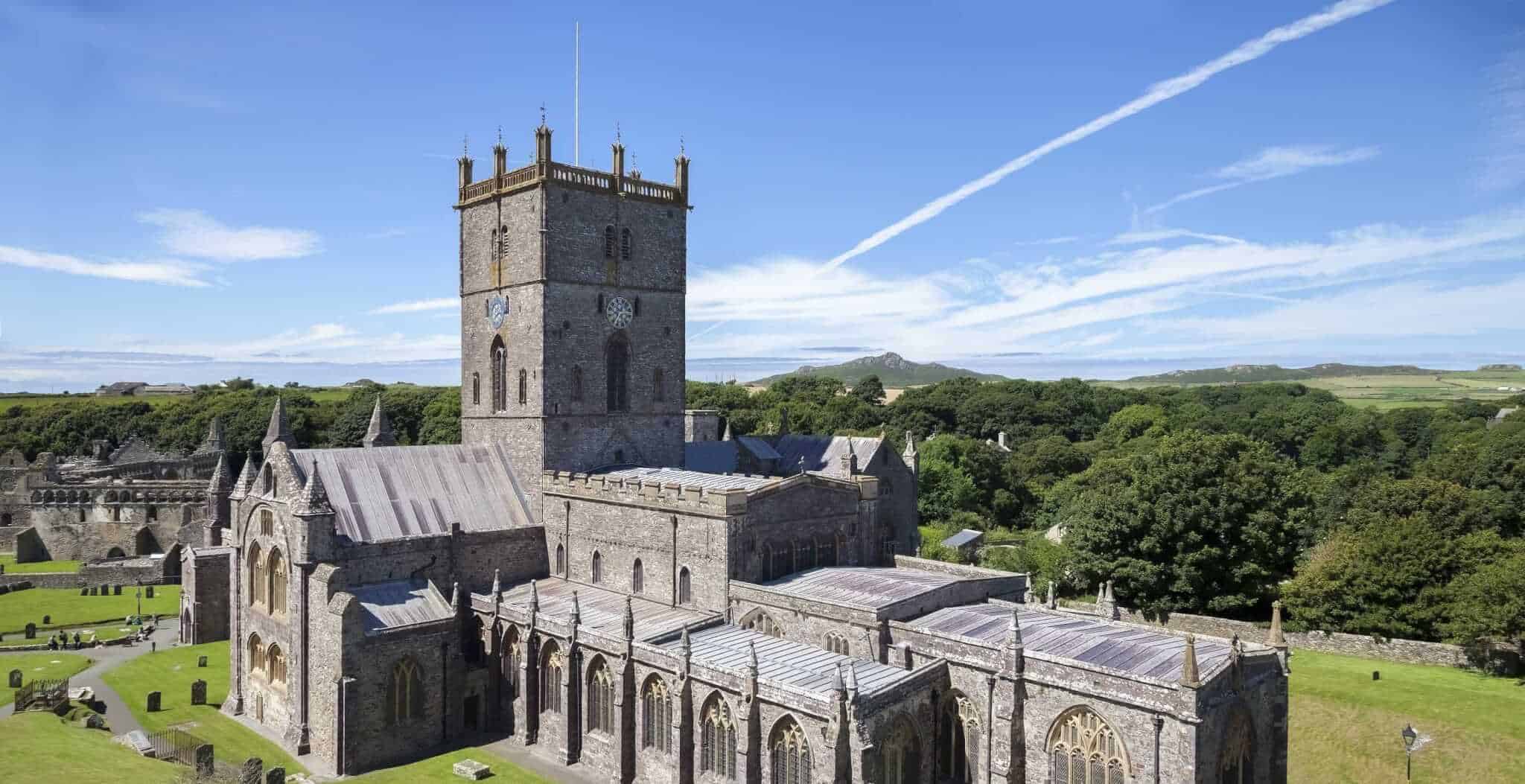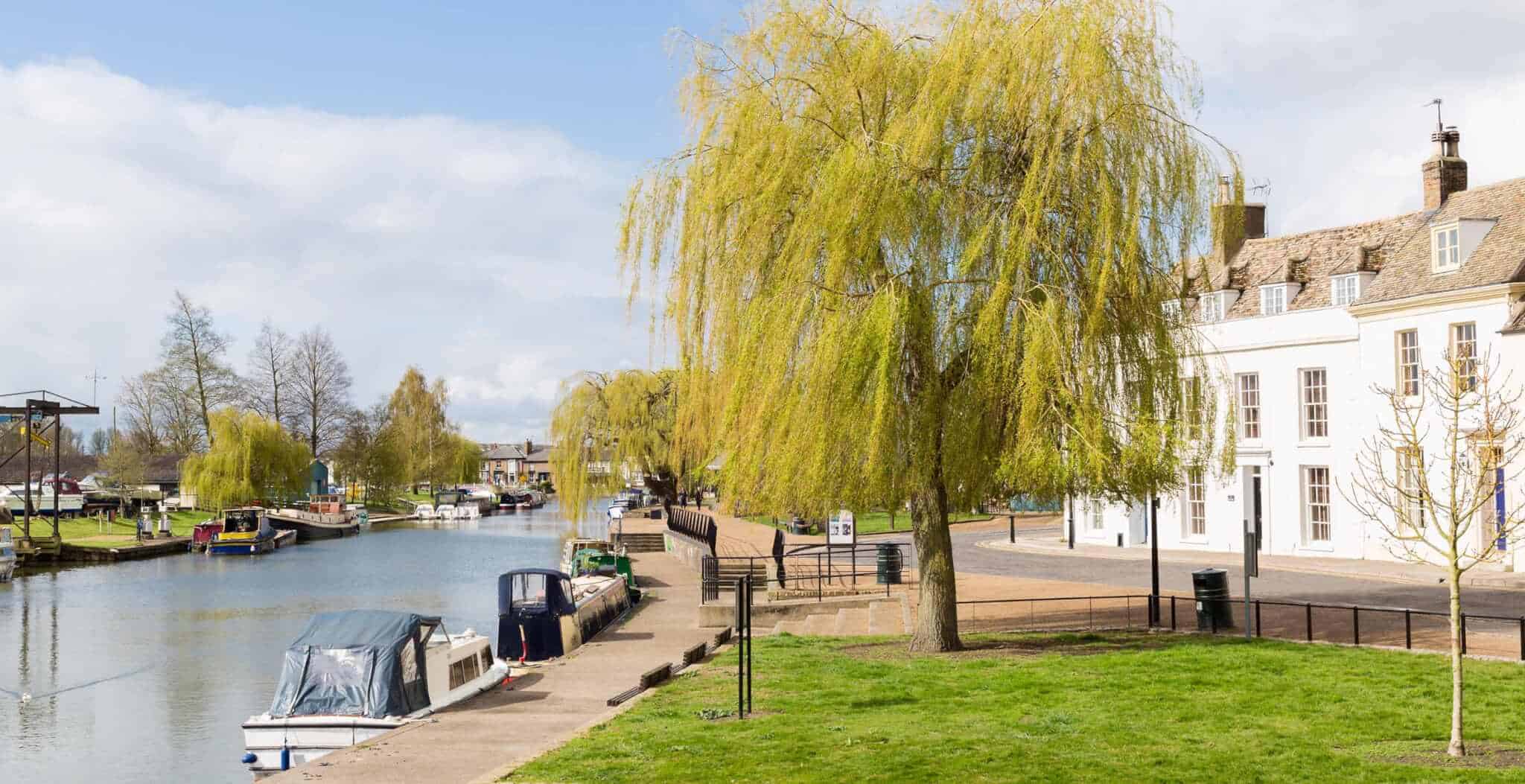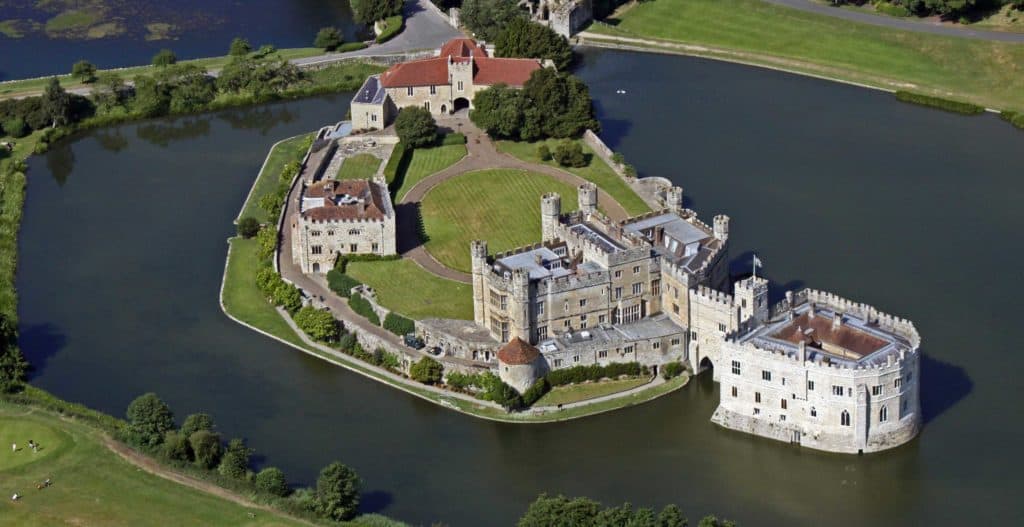From the world-famous St Paul’s in London to the charming 12th century St David’s Cathedral in Wales, simply scroll down to see our interactive map of the Christian cathedrals in Britain. Although we have attempted to be as thorough as possible, please do not hesitate to contact us if you have a cathedral that we have not included on the map.
What is a Cathedral? A cathedral is not just a large church. The word ‘cathedral’ comes from the Latin word cathedra meaning ‘seat’ or ‘chair’, and refers to the presence of the bishop’s or archbishop’s chair or throne. It is the most important church in the diocese.
What is a Minster – is it the same as a Cathedral? Sometimes but not always. Minsters were established during Anglo-Saxon times and were the churches attached to a monastery or monasterium. Nowadays the term ‘minster’ has come to refer more generally to any large or important, often parish, church. Famous minsters include York Minster, Southwell Minster and Westminster in London.
Cathedrals in England
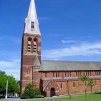 Aldershot Cathedral Aldershot CathedralRoman Catholic Church The Cathedral Church of St Michael and St George serves as the Roman Catholic cathedral for the Bishopric of the Forces, which provides chaplains to the British Armed Forces. The church was designed in 1892 by two military engineers, originally intended as the principal church for the Anglican chaplaincies of the British Army, it eventually became the seat of the Roman Catholic Bishop of the Forces instead. |
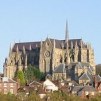 Arundel Cathedral Arundel CathedralRoman Catholic Church The Cathedral Church of Our Lady and St Philip Howard, was dedicated in 1873 as the Catholic parish church of Arundel, and designated a cathedral in 1965. The cathedral's location, construction, and design owe much to the Howard family, who, as Dukes of Norfolk and Earls of Arundel, are the most prominent Catholic family in England. The architectural style of the cathedral is French Gothic, a suitable counterpart to their nearby home …Arundel Castle. |
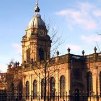 Birmingham Cathedral Birmingham CathedralChurch of England Designed by the English Baroque architect, Thomas Archer, St Philip's was originally built as a parish church in 1715. It became the cathedral of the newly formed Diocese of Birmingham in 1905. |
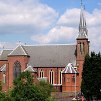 Birmingham Cathedral Birmingham CathedralRoman Catholic Church The Metropolitan Cathedral Church and Basilica of Saint Chad was the first Catholic cathedral to be built in England after the English Reformation initiated in 1534 by King Henry VIII. Designed by Augustus Pugin, it was completed in 1841 and raised to cathedral status in 1852. |
 Blackburn Cathedral Blackburn CathedralChurch of England One of England's newest cathedrals, with the creation of the Diocese of Blackburn in 1926, the parish church of St Mary the Virgin was elevated to cathedral status. The church, which was built in 1826, now forms the cathedral's nave. |
 Bradford Cathedral Bradford CathedralChurch of England A site of Christian worship since Anglo-Saxon times, a later Norman church stood for 300 years before being destroyed by raiding Scots. During the fourteenth century the church was rebuilt, the oldest parts of the present building were completed in 1458. |
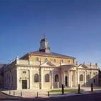 Brentwood Cathedral Brentwood CathedralRoman Catholic Church The Roman Catholic Cathedral Church of St Mary and St Helen dates from 1861. Originally a parish church built in a gothic style, this relatively small building was elevated to Cathedral status in 1917. Enlarged between 1989-1991, the new cathedral was dedicated on 31 May 1991. |
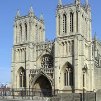 Bristol Cathedral Bristol CathedralChurch of England Founded as St Augustine's Abbey in 1140, the Cathedral Church of the Holy and Undivided Trinity became the seat of the bishop and cathedral of the new Diocese of Bristol in 1542. |
 St Edmundsbury Cathedral St Edmundsbury CathedralChurch of England A church has stood on the site of the current cathedral for over a 1,000 years. Largely rebuilt in the 16th century St James Church became St Edmundsbury Cathedral in 1914. |
 Canterbury Cathedral Canterbury CathedralChurch of England One of the oldest and most famous Christian buildings in England, the Cathedral and Metropolitical Church of Christ at Canterbury, is the seat of the Archbishop of Canterbury, leader of the Church of England and head of the worldwide Anglican Communion. Founded in 597, it was completely rebuilt 1070-77. |
 Carlisle Cathedral Carlisle CathedralChurch of England The second smallest (after Oxford), of England's ancient cathedrals, the Cathedral Church of the Holy and Undivided Trinity was founded as an Augustinian monastery in 1122, and was elevated to cathedral status in 1133. |
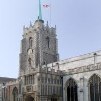 Chelmsford Cathedral Chelmsford CathedralChurch of England Originally dedicated to St Mary the Virgin, the first church on the site of the present Cathedral was founded, along with the town of Chelmsford itself, some 800 years ago. It became a Cathedral in 1914. |
 Chester Cathedral Chester CathedralChurch of England Formerly the abbey church of St Werburgh's, a Benedictine monastery, the cathedral is part of a heritage site that also includes the former monastic buildings. The cathedral has been modified many times from its foundation in 1093, through to the early 16th century. |
 Chichester Cathedral Chichester CathedralChurch of England Founded as a cathedral in 1075, when the seat of the bishop was moved from nearby Selsey. It was completed under Bishop Ralph de Luffa in time for its dedication to the Holy Trinity in 1108. |
 Clifton Cathedral Clifton CathedralRoman Catholic Church Commissioned in 1965, the Roman Catholic Cathedral Church of SS. Peter and Paul was constructed over a three year period and was consecrated on 29th June 1973 |
 Coventry Cathedral Coventry CathedralChurch of England The new St Michael's Cathedral stands alongside the ruined shell of its predecessor, destroyed in a bombing raid during the Second World War. Together in hallowed ground, the two create one living Cathedral. |
 Derby Cathedral Derby CathedralChurch of England The building previously known as All Saints' Church, became a cathedral in 1927. The current structure dates mainly from the 18th century with a 16th century tower, although the original church was founded in 943 by King Edmund I. |
 Durham Cathedral Durham CathedralChurch of England Founded in 1093, the cathedral is regarded as one of the finest examples of Norman architecture and replaced the 10th century "White Church", which was built as part of a monastic foundation to house the shrine of Saint Cuthbert of Lindisfarne. |
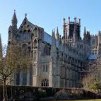 Ely Cathedral Ely CathedralChurch of England Known locally as "the ship of the Fens", the Cathedral Church of the Holy and Undivided Trinity of Ely dates from 1083. It stands on the site of a much earlier Anglo-Saxon church, founded by St. Etheldreda around 673. |
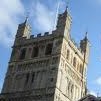 Exeter Cathedral Exeter CathedralChurch of England The founding of a cathedral at Exeter dates from 1050, when the seat of the bishop of Devon and Cornwall was moved from Crediton, due to the fear of pagan raids from the sea. The present Cathedral Church of Saint Peter at Exeter, was completed around 1400, although Its official foundations date from 1133. |
 Gloucester Cathedral Gloucester CathedralChurch of England The origins of the Cathedral Church of St Peter and the Holy and Indivisible Trinity date from Osric, an Anglo-Saxon prince in 678. The foundations of the present church were laid by Abbot Serlo in 1089. |
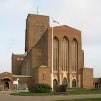 Guildford Cathedral Guildford CathedralChurch of England Stands in a commanding position, the solid red brick outline of the Cathedral Church of the Holy Spirit, Guildford, can be seen from from miles around. Construction of the cathedral began in 1936, however the Second World War delayed its consecration until 1961. |
 Hereford Cathedral Hereford CathedralChurch of England Although a place of Christian worship since the 8th century, the earliest surviving building is the 11th century bishop's chapel. The current medieval Cathedral Church of St Mary the Virgin and St Ethelbert the King, dates mainly from the 14th to 16th centuries. |
 Lancaster Cathedral Lancaster CathedralRoman Catholic Church A former a Roman Catholic parish church dating from 1859, it was elevated to the status of the Cathedral Church of St Peter, in 1924. |
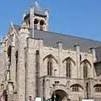 Leeds Cathedral Leeds CathedralRoman Catholic Church Built in 1878, the original cathedral was located in St. Anne's Roman Catholic Church, but that building was demolished by Leeds Corporation in 1899. A new site was found and the current cathedral building was completed in 1904. |
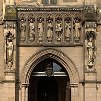 Leicester Cathedral Leicester CathedralChurch of England A church dedicated to St Martin has been on the current site since 1086, when the older Saxon church was replaced by a Norman one. The church was elevated to Cathedral status in 1927. |
 Lichfield Cathedral Lichfield CathedralChurch of England The religious centre of the Kingdom of Mercia since 669, the early wooden Saxon church of St Chad was replaced by a Norman cathedral in 1085, then by the current Gothic cathedral begun in 1195. |
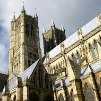 Lincoln Cathedral Lincoln CathedralChurch of England Construction of the Cathedral Church of the Blessed Virgin Mary of Lincoln, began in 1088 and continued throughout the medieval period. Suffering fire and earthquakes in its early years, it was said to be the tallest building in world for 238 years, until its central spire collapsed in 1549. |
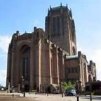 Liverpool Cathedral Liverpool CathedralChurch of England Although the foundation stone was laid by King Edward VII in 1904, the building of the cathedral was delayed first through design and redesign issues, and then still further by two world wars. A service of dedication was finally held in October 1978. |
 Liverpool Metropolitan Cathedral Liverpool Metropolitan CathedralRoman Catholic Church Initially, Sir Edwin Lutyens was commissioned to provide a design, which if built, would have become the second-largest church in the world. Building work began in June 1933. In 1941, the restrictions of World War II and rising costs from £3-£27 million, forced construction to stop. Work eventually recommenced on the crypt, which was finished in 1958. The present Cathedral was designed by Sir Frederick Gibberd. Construction took place between October 1962 and May 1967, but soon after its opening, it began to exhibit architectural flaws. This led to the cathedral authorities suing Sir Frederick for £1.3 million. |
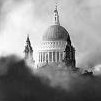 London Cathedral (St Paul's) London Cathedral (St Paul's)Church of England A cathedral dedicated to St Paul has stood atop Ludgate Hill, the highest point in the City of London, for more than 1,400 years. The present structure, the masterpiece of Sir Christopher Wren, is at least the fourth to have stood on the site. Built between 1675 and 1710, after its predecessor was destroyed by the Great Fire of London. |
 London Cathedral London CathedralRoman Catholic Church The Cathedral of the Holy Family in Exile, is the cathedral of the Ukrainian Greek Catholic Apostolic Exarchate in Great Britain. The structure was designed by Alfred Waterhouse, the architect of the Natural History Museum, and built as the King’s Weigh House Chapel in 1891. |
 Manchester Cathedral Manchester CathedralChurch of England Although extensively restored and extended during the Victorian era, and then again after severe bomb damage during the Manchester Blitz of 1940, the main body of the Cathedral and Collegiate Church of St Mary, St Denys and St George, largely derives from a medieval parish church |
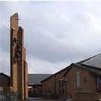 Middlesbrough Cathedral Middlesbrough CathedralRoman Catholic Church The Roman Catholic Cathedral Church of St Mary the Virgin is a modern, light building, specifically designed to involve the congregation in active participation. An earlier cathedral, on another site in the city, had served the community since 1879. |
 Newcastle Cathedral Newcastle CathedralChurch of England The Cathedral Church of St Nicholas, is named after the patron saint of sailors and boats. Originally a parish church dating from 1091, this was destroyed by fire in 1216 and later rebuilt in 1359. It became a cathedral in 1882 when the Diocese of Newcastle was created. |
 Newcastle Cathedral Newcastle CathedralRoman Catholic Church The Roman Catholic Cathedral Church of St. Mary, was designed by Augustus Welby Pugin and built in the Gothic Revival style of architecture championed by him, between 1842 and 1844. It gained the status of a cathedral church in 1850. |
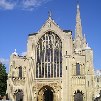 Norwich Cathedral Norwich CathedralChurch of England Dedicated to the Holy and Undivided Trinity, Norwich Cathedral was built between 1096-1145 and added to throughout the medieval period. An earlier Saxon settlement and two churches were demolished to make room for the buildings. |
 Norwich Cathedral Norwich CathedralRoman Catholic Church The Cathedral Church of St John the Baptist is the second largest Roman Catholic cathedral in England. Constructed between 1882 and 1910 as a parish church, it was consecrated as the cathedral for the Diocese of East Anglia in 1976. |
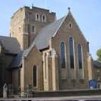 Northampton Cathedral Northampton CathedralRoman Catholic Church The origins of the Roman Catholic Cathedral Church of St Mary and St Thomas date back to 1840, when Augustus Pugin was commissioned to design a collegiate chapel. Pugin's son Edward, was invited to further extend the building creating the current cathedral, which opened in 1864. |
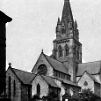 Nottingham Cathedral Nottingham CathedralRoman Catholic Church Designed by Augustus Pugin, the Roman Catholic Cathedral Church of St. Barnabas was built between 1841-1844. It was raised to cathedral status in 1852, by a decree of Pope Pius IX. |
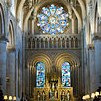 Oxford Cathedral Oxford CathedralChurch of England Christ Church Cathedral is the cathedral for the Diocese of Oxford, in addition, it is also the chapel of Christ Church, a college of the University of Oxford. Originally the church of St Frideswide's Priory, Cardinal Wolsey began the building of his college here in 1522. |
 Peel Cathedral Peel CathedralChurch of England The Cathedral Church of Saint German on the Isle of Man, is the parish church of the parish of German, which was built 1879-84. It was made a cathedral by an Act of Tynwald in 1980. The remains of the original cathedral (circa 1183) lie within the walls of Peel Castle, which fell into ruin in the 18th century. |
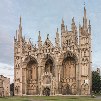 Peterborough Cathedral Peterborough CathedralChurch of England With its origins dating back to King Peada, who founded the first monastery on the site in 655. It was built in its present form between 1118 and 1238, and became the Cathedral of the new Diocese of Peterborough in 1541. |
 Plymouth Cathedral Plymouth CathedralRoman Catholic Church The Cathedral Church of St Mary and St Boniface first opened for Catholic Mass on 25th March 1858, and was consecrated in September 1880. The Patron St Boniface was born in nearby Crediton. |
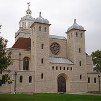 Portsmouth Cathedral Portsmouth CathedralChurch of England Around 1180, Jean de Gissor, a wealthy Norman merchant gifted land to Augustinian canons, to build a chapel "to the Glorious Honour of the Martyr Thomas of Canterbury." The chapel first became a parish church in the 14th century and a cathedral in the 20th century. |
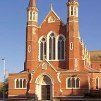 Portsmouth Cathedral Portsmouth CathedralRoman Catholic Church St John's Cathedral opened for worship in August 1882 and was immediately made the Mother Church of the new Catholic Diocese of Portsmouth. It replaced a chapel built in 1796, which subsequently closed. The cathedral was completed in four phases, between 1882 and 1906 |
 Ripon Cathedral Ripon CathedralChurch of England Saint Wilfred built one of England’s first stone churches on this site in 672. Today’s church is the fourth to have occupied this site. The tiny 7th century chapel remains complete beneath the later grandeur of Archbishop Roger de Pont l’Evêque’s 12th century minster. |
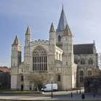 Rochester Cathedral Rochester CathedralChurch of England The second oldest bishopric in England, the Rochester diocese was founded by Justus, one of the missionaries who accompanied St Augustine of Canterbury in the early 7th century. The present building dates back to the work of the French monk, Gundulf, in 1080. |
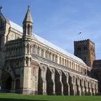 St Albans Cathedral St Albans CathedralChurch of England The Cathedral and Abbey Church of St Alban is dedicated to Britain's first Christian martyr. Alban surrendered his life for his faith in the pre-Christian Roman city of Verulamium, present day St Albans. Much of its present architecture is Norman, and it became a cathedral in 1877. |
 Salford Cathedral Salford CathedralRoman Catholic Church The Cathedral Church of St. John the Evangelist was built between 1844-48 to designs of Matthew Ellison Hadfield. It was the first Catholic church to be built in cruciform shape since the Reformation and was closely modelled on the Gothic builders of the 13th and 14th centuries. |
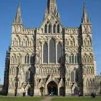 Salisbury Cathedral Salisbury CathedralChurch of England In 1220 AD Bishop Richard Poore and his architect Elias de Derham set about building a new state-of-the-art Gothic style cathedral to replace the old Norman Cathedral at Old Sarum. Completed in just 38 years, it features a single consistent architectural style. |
 Sheffield Cathedral Sheffield CathedralChurch of England Originally a parish church, the Cathedral Church of St Peter and St Paul, Sheffield was elevated to cathedral status when the new diocese was created in 1914. The current structure has been changed and rebuilt over several centuries. |
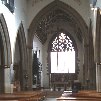 Sheffield Cathedral Sheffield CathedralRoman Catholic Church Designed by Matthew Ellison Hadfield, the Roman Catholic Cathedral Church of St Marie was closely modelled on a 14th century church at Heckington, Lincolnshire. St Marie’s opened in 1850, and was consecrated after the building debt had been paid off in 1889. |
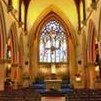 Shrewsbury Cathedral Shrewsbury CathedralRoman Catholic Church Designed by Edward Pugin the son of Augustus, the Roman Catholic Cathedral Church of Our Lady, Help of Christians and St. Peter of Alcantara, was completed in 1856. A much grander building had been planned, but these designs could not be carried out due to the site's weak foundations. |
 Southwark Cathedral Southwark CathedralChurch of England The Cathedral and Collegiate Church of St Saviour and St Mary Overie 'over the water' has been a place of Christian worship for more than 1,000 years, but a cathedral only since the creation of the diocese of Southwark in 1905. The church in its present form, dates between 1220-1420. |
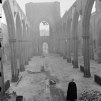 Southwark Cathedral (or St George's Cathedral) Southwark Cathedral (or St George's Cathedral)Roman Catholic Church Situated opposite the Imperial War Museum close to Waterloo station, St George's Cathedral was consecrated in 1848 but was heavily damaged by bombing in World War 2. The photo on the right shows a priest surveying the damage. |
 Southwell Minster Southwell MinsterChurch of England The earliest church on the site is believed to have been founded in 627. The Norman reconstruction of the minster began in 1108, probably as a gradual rebuilding of the Anglo-Saxon stone church. The minster finally became a cathedral in 1884. |
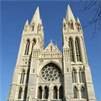 Truro Cathedral Truro CathedralChurch of England The Cathedral of the Blessed Virgin Mary, Truro, was built in the Gothic Revival architectural style between 1880 -1910, on the site of the 16th century parish church of St Mary the Virgin. |
 Wakefield Cathedral Wakefield CathedralChurch of England The Cathedral Church of All Saints is situated in the centre of Wakefield, on the site of a Saxon church. The current Norman structure was rebuilt in 1329, and rebuilt and enlarged again in 1469. All Saints Church became the cathedral of the diocese in 1888. |
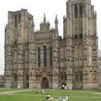 Wells Cathedral Wells CathedralChurch of England The first church was established on the site in 705 by King Ine of Wessex. Construction of the present cathedral began in 1175 and was largely complete at the time of its dedication in 1239. |
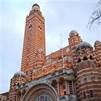 Westminster Cathedral Westminster CathedralRoman Catholic Church Westminster Cathedral in London is the mother church of the Catholic community in England and Wales. The site was purchased by the Archdiocese of Westminster in 1885 and construction started in 1895. The cathedral opened in 1903, however due to a quirk of Catholic Church law the consecration ceremony did not take place until June 1910. |
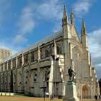 Winchester Cathedral Winchester CathedralChurch of England A cathedral was founded close to the current building in 652, when England’s pagan monarchy first became Christians. Known as the Old Minster, it was demolished in 1093, immediately after the consecration of its new Norman successor. |
 Worcester Cathedral Worcester CathedralChurch of England The current Cathedral Church of Christ and the Blessed Mary the Virgin of Worcester, was built between 1084-1504, and as such almost every style of English architecture is represented. The older Saxon cathedral it replaced was founded in 680. |
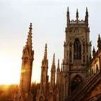 York Minster York MinsterChurch of England The minster is the seat of the Archbishop of York, the second-highest office of the Church of England. The first recorded church on the site was a wooden structure hurriedly built in 627 to provide a place to baptise Edwin, King of Northumbria. The current Norman style building dates from 1080, which has been added to over the centuries. |
Cathedrals in Scotland
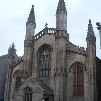 Abderdeen Cathedral Abderdeen CathedralScottish Episcopal Church The Episcopal Cathedral Church of St Andrew opened in 1817 as St Andrew's Chapel and was raised to Cathedral status in 1914. Designed by local architect Archibald Simpson, who became famous for planning the new town of Edinburgh. |
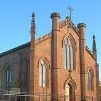 Ayr Cathedral Ayr CathedralRoman Catholic Church The Cathedral Church of Saint Margaret, also known as Ayr Cathedral, is the mother church of the Roman Catholic Diocese of Galloway. St Margaret’s was designated a cathedral in 2007, and is the most recent church to be given status as a Roman Catholic cathedral in the United Kingdom. |
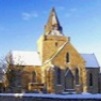 Dornoch Cathedral Dornoch CathedralChurch of Scotland Dornoch Cathedral was built in the 13th century during the reign of King Alexander II as the cathedral church of the diocese of Caithness. It was built by Gilbert de Moravia, Bishop of Caithness, at his own expense. Almost totally destroyed during a fire in 1570, it was partially restored in 1616 and fully restored in 1837. |
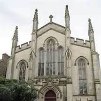 Dundee Cathedral Dundee CathedralScottish Episcopal Church Built on the site a medieval seat of power in the area, the foundation stone of the Anglican St Paul's Cathedral was laid on 21 July 1853 and it was completed in 1855. Designed by George Gilbert Scott in Middle Gothic style, it was raised to cathedral status in 1905. |
 Edinburgh St Mary's Episcopal Cathedral Edinburgh St Mary's Episcopal CathedralScottish Episcopal Church Designed by Sir George Gilbert Scott, St Mary’s Episcopal Cathedral, the Mother Church of the Diocese of Edinburgh, was consecrated in 1879. St Mary’s is Scotland’s largest cathedral, and a fine example of Victorian Gothic architecture. |
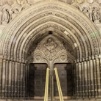 Edinburgh St Giles Cathedral Edinburgh St Giles CathedralChurch of Scotland Also known as the High Kirk of Edinburgh, St Giles is dedicated to the patron saint of Edinburgh. A place of worship for over 900 years, the present cathedral dates from the late 14th century but with extensive 19th century restorations. |
 Glasgow Cathedral Glasgow CathedralChurch of Scotland Glasgow church is reputedly built on the same site where the Patron Saint of Glasgow, St Mungo, built his own church in the early 7th century. The current building dates from the 13th century, and is one of the few medieval cathedrals in Scotland to have survived the reformation intact. |
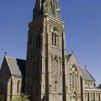 St Mary's Cathedral, Glasgow St Mary's Cathedral, GlasgowScottish Episcopal Church The Cathedral Church of St Mary the Virgin, was opened on 9 November 1871 as St Mary's Episcopal Church and was completed in 1893. Designed by Sir George Gilbert Scott, it was raised to cathedral status in 1908. It is one of four cathedrals in Glasgow. |
 Inverness Cathedral Inverness CathedralScottish Episcopal Church The Episcopal Cathedral Church of Saint Andrew was designed by local architect Alexander Ross, with construction starting in 1866, the building work was completed in 1869. A lack of funding meant that the two giant spires featured in his design were never realised. |
 Millport Cathedral Millport CathedralScottish Episcopal Church The Cathedral of The Isles and Collegiate Church of the Holy Spirit is Britain’s smallest Cathedral and dates from 1851. Planned as a theological college for the Scottish Episcopal Church, it was seen as a “new” Iona, and in 1876 was consecrated Cathedral of the Isles. |
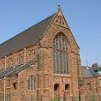 Motherwell Cathedral Motherwell CathedralRoman Catholic Church The Cathedral Church of Our Lady of Good Aid, popularly known as Motherwell Cathedral, opened as a Roman Catholic parish church in December 1900, it was elevated to the status of cathedral in 1948. |
 Oban Cathedral Oban CathedralScottish Episcopal Church The congregation of the Cathedral Church of St John the Divine first gathered in 1846. Construction work continued on the structure until 1910, when funds ran out. |
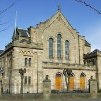 Paisley Cathedral Paisley CathedralRoman Catholic Church Dedicated to the patron saint of Paisley, the Cathedral Church of Saint Mirin was completed in 1931. A former Roman Catholic parish church, it was raised to cathedral status in 1948. Neo-Romanesque in style, its architect was Thomas Baird. |
 Perth Cathedral Perth CathedralScottish Episcopal Church The Cathedral Church of St Ninian was built on the site of an older Dominican monastery and was the first to be built in Britain since the Reformation, being consecrated in 1850. Designed by the London architect, William Butterfield, it was completed by 1914. |
Cathedrals in Wales
 Bangor Cathedral Bangor CathedralThe Church in Wales Originally occupied by St. Deiniol's monastery, established around 525, Bangor Cathedral is located on a low-lying and inconspicuous site, possibly to avoid the attention of raiders from the sea. The earliest part of the present building dates from the episcopate of Bishop David 1120–1139. Today's structure is the result of extensive work carried out under the supervision of Sir George Gilbert Scott begun in 1868. |
 Brecon Cathedral Brecon CathedralThe Church in Wales Previously the church of Brecon Priory founded in 1093, and later the 16th century Parish Church of St John the Evangelist, it became Brecon Cathedral in 1923. It is thought that the Norman Priory might have been built on the site of an older, possibly Celtic, church. |
 Cardiff Cathedral Cardiff CathedralRoman Catholic Church The Roman Catholic Metropolitan Cathedral Church of St David was designed by the London firm of architects of Pugin & Pugin and constructed between 1884-87. Damaged by World War II bombing in 1941, it was restored and rebuilt during the 1950’s and re-opened in March 1959. |
 Llandaff Cathedral Llandaff CathedralThe Church in Wales The Cathedral Church of SS Peter & Paul, Dyfrig, Teilo and Euddogwy, is one of two cathedrals in Cardiff, the other being the Catholic Cardiff Cathedral. The current building was constructed in the 12th century over the site of an earlier church. |
 Newport Cathedral Newport CathedralThe Church in Wales Newport’s St. Woolos Cathedral has sections that date from Anglo-Saxon times, together with a large 12th century Norman Nave enclosed within later mediaeval aisles. Restored whilst still a church in 1850, St. Woolos attained full cathedral status in 1949. |
 St Asaph Cathedral St Asaph CathedralThe Church in Wales Saint Kentigern built his church on this site in 560. When he returned to Strathclyde in 573, he left Asa (or Asaph) as his successor. Since that time the Cathedral has been dedicated to Saint Asaph. Reputed to be the smallest Anglican cathedral in Great Britain, the present building dates mainly from the 13th century. |
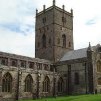 St David's Cathedral St David's CathedralThe Church in Wales The monastic community was founded by Saint David (Welsh: Dewi Sant), Abbot of Menevia, during the 6th century. During the next 450 years the monastery was regularly plagued by sea-born raiders. In 1115, with the area now under Norman control, the life of the community began to improve and construction of a new Cathedral began. The present Cathedral was started in 1181, and completed shortly afterwards. |
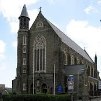 Swansea Cathedral Swansea CathedralRoman Catholic Church The Roman Catholic Cathedral Church of Saint Joseph was designed by Peter Paul Pugin and took two years to build. Originally dedicated as a church the building opened in 1888, and was elevated to a cathedral status in 1987. |
 Wrexham Cathedral Wrexham CathedralRoman Catholic Church Originally built as a Roman Catholic Parish Church in 1857, the Cathedral Church of Our Lady of Sorrows was designed by Edward Welby Pugin, son of the famous Augustus. In true family tradition, it adopted a 14th century Gothic Style. |
Have we missed something?
Although we've tried our hardest to list every cathedral in Britain, we're almost positive that a few have slipped through our net... that's where you come in!
If you've noticed a site that we've missed, please help us out by filling in the form below. If you include your name we'll be sure to credit you on the website.
